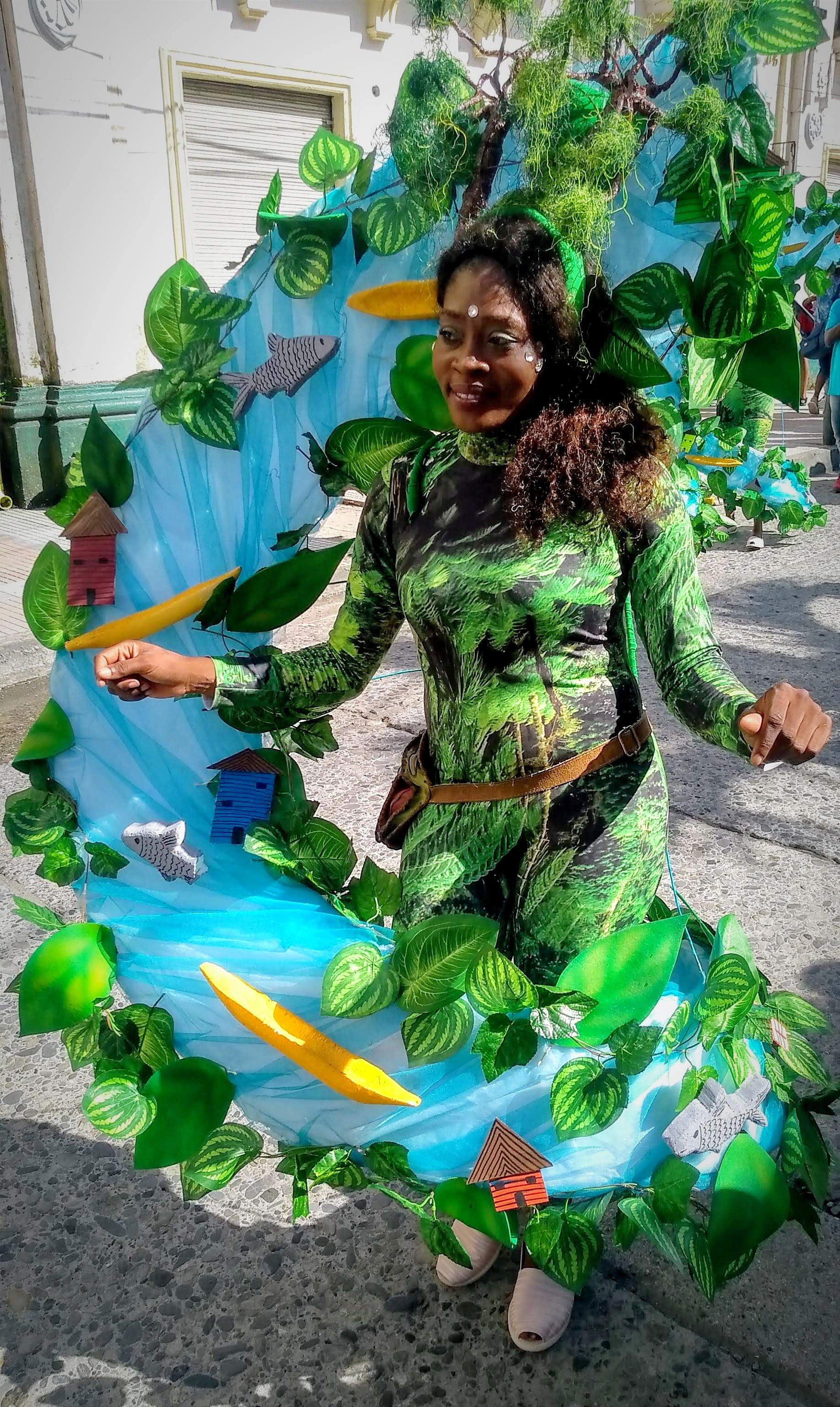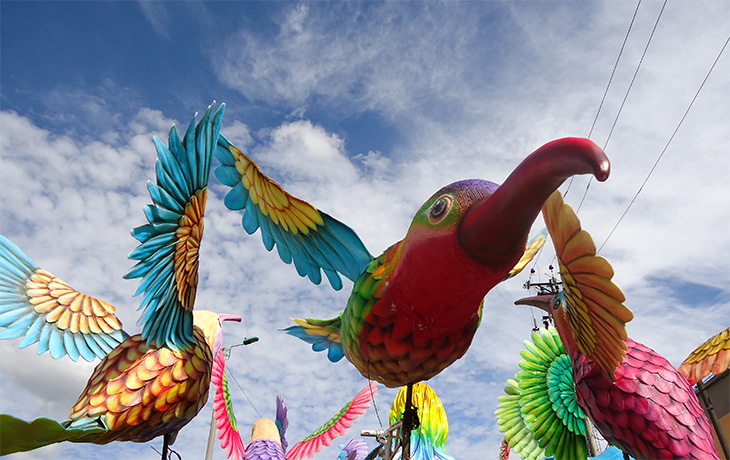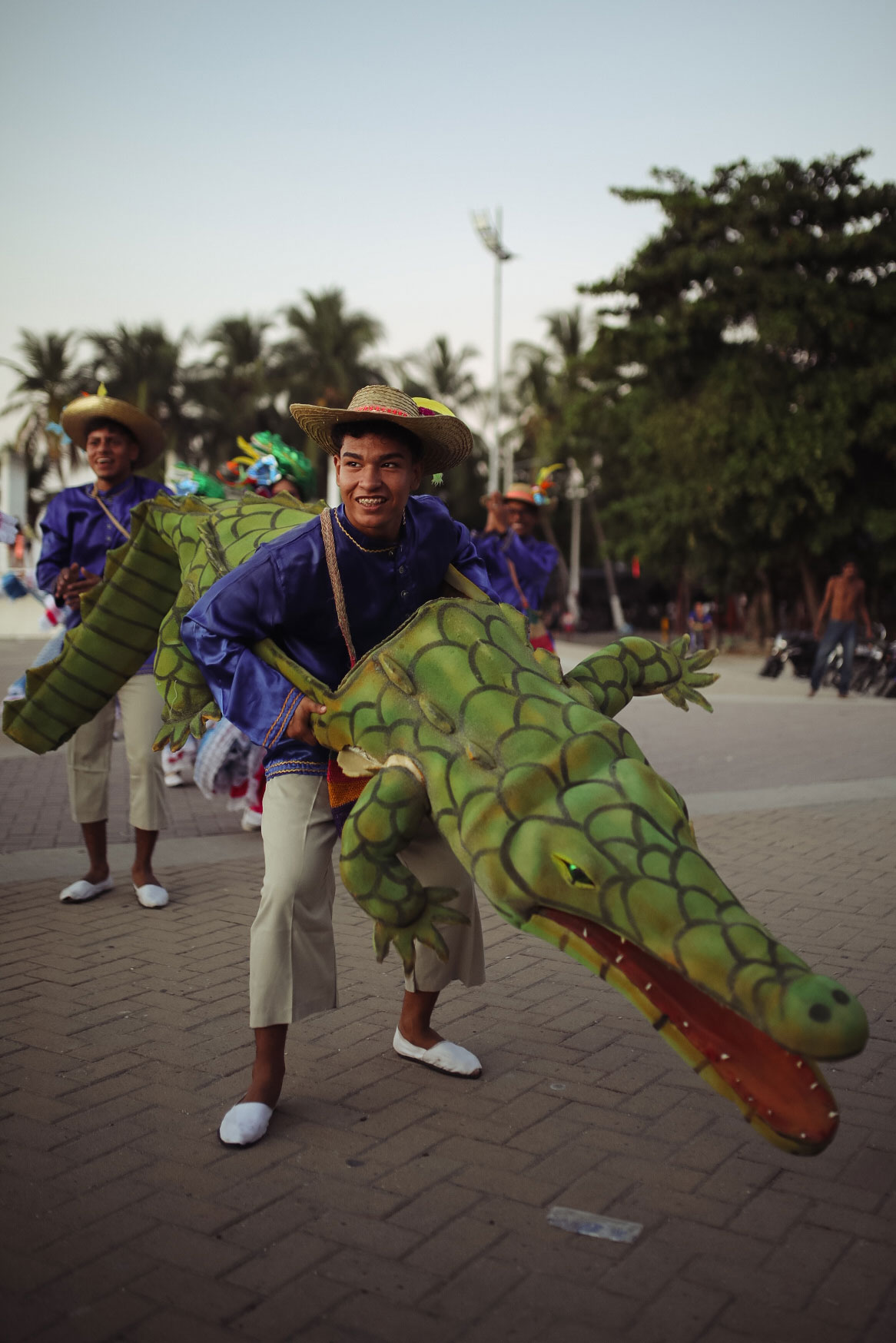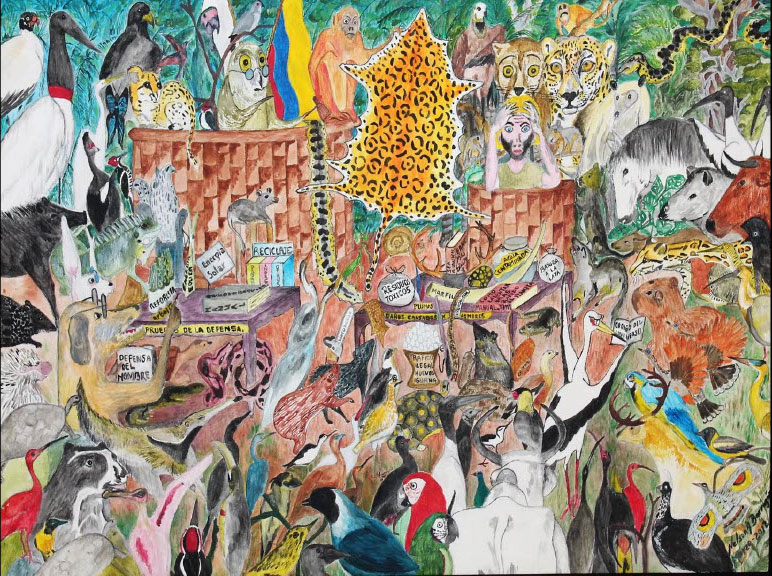
A resident in the city of Quibdó, Colombia, dressed as the Atrato river and its biodiversity at the Festival of San Pacho. The costume exemplifies the intricate connection between biodiversity and cultural diversity. The festival was added to the UNESCO’s Representative List of the Intangible Cultural Heritage of Humanity in 2012, and was described as the most important symbolic event in the life of the city of Quibdó. Photo by Stephanie Ontiveros Ospina.
Around the world people have developed strong, intimate connections with their surrounding wildlife and ecosystems. From traditional dances to inspiring ways of knowing and being, wildlife is woven into the fabric of cultures worldwide. This connection is evident in countless traditions, such as songs, dances, and art that celebrate animals, plants, rivers, and forests. New research reveals that in Colombia, regions with the highest biocultural richness—places where biodiversity and cultural diversity are deeply intertwined—largely overlap with territories of Indigenous peoples and Afro-Colombian communities.
A new study published in People and Nature led by ESPM professor Alejandra Echeverri, integrates biology, anthropology, music, and geography to map the places where biodiversity and cultural diversity overlap, highlighting areas with the greatest potential for sustainable ecotourism development. The research was focused on Colombia—one of the most biodiverse countries on Earth and host of last month’s United Nations Convention on Biological Diversity (COP16)—and provides a framework that could be applied elsewhere for ecotourism planning.
Exploring the relationship between biodiversity and cultural diversity
Biodiversity and cultural diversity can be mapped in different ways for ecotourism purposes. The study researchers, who are ecologists, musicians, anthropologists, and spatial analysts, focused on mapping species and cultural practices that draw tourists to a location. For example, they charted the distribution of birds, mammals, fishes, and other species under the premise that tourists might go birdwatching or sports fishing.
Similarly, they also mapped music festivals, UNESCO Intangible Cultural Heritage sites, and territories of Afro-Colombian and Indigenous peoples. They focused on practices and communities recognized by UNESCO and Colombia’s national constitution, as well as events that communities make public, such as music festivals where cultural diversity is embraced and celebrated.

A float showing hummingbirds native to Pasto, a city in southern Colombia, on display during the Great Parade of the city’s "Festival of Negros y Blancos.” The festival tells the story of Colombia, Indigenous traditions, slavery, and independence, and dates back to the celebrations that Indigenous peoples in this region held to give thanks for the harvests. The Great Parade features floats that depict ancestral figures, myths and legends, and local biodiversity. Photo by Maria Angelica Guerrero Quintana.
"People often perceive areas like the Amazon as 'pristine forests' solely from a wildlife perspective," said Echeverri, who started this project as a postdoctoral scholar at Stanford’s Natural Capital Project with funding from the McCoy Family Center for Ethics and Society. "Our research shows that in one of the most megadiverse countries in the world, biodiversity and cultural diversity are deeply intertwined." What might appear as untouched wilderness is, in fact, a landscape where cultural diversity thrives alongside biodiversity. For instance, in the Caribbean region, music festivals like the Carnival of Barranquilla—Colombia's largest and most famous carnival, recognized by UNESCO as a masterpiece of the Intangible Heritage of Humanity—coincide with areas rich in endemic species, such as the Sapphire-bellied Hummingbird (Chrysuronia lilliae)” safety.
“If you look across Colombia, rhythms like the Marimbas del Pacífico and Vallenatos, played along the Pacific and Caribbean coasts, respectively, feature lyrics and beats that reflect their surrounding ecosystems and wildlife,” noted co-author Armando Dávila Arenas, a musician and ethnomusicologist based in Colombia.
Identifying areas of high biocultural value

Two Caribbean residents in the Carnival of Barranquilla (2023) dancing and dressed as the American crocodyle (Crocodylus acutus). This species plays a very important role in culture, with many songs being written about it. Photo by: Robinson Manuel Ruz Sampayo
Most studies typically focus on either biodiversity or cultural heritage. By incorporating experts from multiple disciplines, including freshwater ecology and anthropology, this research offers new insights. "Places like Vaupés, in Southeastern Colombia and north Amazonia, are remarkable biocultural territories,” said Colombian anthropologist and study co-author Federico Andrade Rivas. "This area is home to various Indigenous peoples, including the Tukano, Cubeo, and Desano peoples, who belong to different language families such as Tukanoan, Arawakan, and Maku, contributing to an extraordinary concentration of linguistic diversity in a relatively small geographic area."
Guido A. Herrera-R, a Colombian freshwater ecologist, added that the Vaupés River in the Amazon Basin hosts an astonishing diversity of freshwater species, including many undescribed and little-known species from the fast-flowing waters of Matapí Rapids, making it a biodiversity hotspot. “The recognition of fishes and freshwater ecosystems in Colombia, as a source of food, income, and recreation for many people, are offering new possibilities to understand biocultural patterns,” he said.
The study identified several regions in Colombia with high biocultural (combined biological and cultural diversity) value, particularly along the Caribbean and Pacific coasts, the Amazon, and the Orinoquia region near the Venezuelan border. These areas, recognized nationally and internationally for their cultural practices, overlap significantly with territories inhabited by Afro-Colombian and Indigenous peoples. However, the researchers did not find areas that were highly accessible to tourists as well as high in both biodiversity and cultural heritage. This is because most of these culturally rich and biodiverse areas lack infrastructure that draw tourists to a location, such as hotels, airports, or are far from ports that bring tourists via boats.
Informing sustainable ecotourism
Ecotourism can be polarizing. On one hand, the ecotourism sector has a history of exploiting local communities, where their knowledge and sacred sites are used to benefit tourists while eroding their sense of local ownership and perspectives on what makes the place unique. On the other hand, successful examples of sustainable ecotourism often involve co-management, wherein Indigenous sovereignty is respected through federal policies that allow communities to control what is shared with tourists and what remains private. When managed in an inclusive and participatory manner, ecotourism has the potential to promote social mobility and economic growth.
In this study, researchers partnered with Colombian government institutions to prioritize national data sources and policy priorities. For example, Colombia’s birdwatching industry is a multi-million dollar sector, with the country recently passing legislation to promote ecotourism as a sustainable development strategy, officially naming Colombia “The country of the birds.” However, the study shows that ecotourism in Colombia is evolving beyond birdwatching. "We’re seeing a growing interest in combining birdwatching with other activities, such as attending music festivals and freshwater sport fishing," Echeverri said.
“There’s significant overlap between areas with high concentrations of endemic birds, sport fisheries, and cultural festivals,” added Natalia Ocampo-Peñuela, a Colombian professor at the University of California, Santa Cruz. The most sought-after bird species for birdwatching tours are often found in areas under the jurisdiction of Afro-Colombian and Indigenous communities. Marketing these locations as biocultural destinations could attract a broader range of tourists interested in a combination of activities, but it is important this is done in a careful way.
Rethinking ecotourism around the globe

A painting depicting the local fauna and flora of the Colombian llanos in the Orinoquia region, featuring many species of birds, the jaguar, the tapir, and the capybara. The piece also includes people in the llanero culture, whose culture is very embedded in cattle ranching. Photo by Nelson Barragan.
In many tropical countries, such as Brazil, Ecuador, Peru, and Colombia, cultural heritage is deeply intertwined with biodiversity. Similar patterns may exist in other regions of high cultural and ecological diversity, such as Nigeria, Ethiopia, Indonesia, and India.
Even in regions with less biodiversity, like the United States, the findings are still relevant. "Humans have long developed cultural practices tied to their local environment," said Echeverri. "Music, for example, is a universal cultural expression. Traditional music often reflects the landscapes, animals, and plants of a region, evoking a deep emotional connection with nature".
This research points to the need to rethink conservation and ecotourism strategies. "We must recognize that places have value beyond their biodiversity," Echeverri emphasized. "These areas are home to rich cultural traditions and diverse ways of life. Conservation and economic sectors like sustainable ecotourism need to foster authentic partnerships with Indigenous peoples and local communities at all planning stages to ensure their autonomy in dictating which areas of their culture and territories, if any, they are willing to share and commodify in sustainable ecotourism.”
READ MORE
